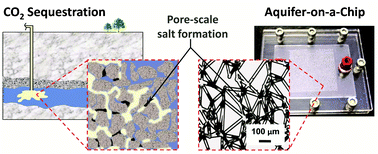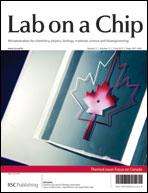In this study, we develop a lab-on-a-chip approach to study pore-scale salt precipitation dynamics during CO2 sequestration in saline aquifers—a challenge with this carbon management strategy. Three distinct phases—CO2 (gas), brine (liquid), and salt (solid)—are tracked through microfluidic networks matched to the native geological formations. The resulting salt formation dynamics indicate porosity decreases of ∼20% in keeping with large scale core studies. At the network scale, the salt precipitation front moves at a constant velocity, ∼2% that of the superficial CO2 velocity in this case. At the pore-scale, we observe two dominant types of salt formation: (1) large bulk crystals, on the order of the pore size (20–50 μm), forming early within trapped brine phases; and (2) polycrystalline aggregated structures, ranging over broad length scales, forming late in the evaporation process and collecting/projecting from the CO2–brine interface. Together, these two salt formation mechanisms show particular propensity for pore blockage and reduced carbon storage capacity.

You have access to this article
 Please wait while we load your content...
Something went wrong. Try again?
Please wait while we load your content...
Something went wrong. Try again?


 Please wait while we load your content...
Please wait while we load your content...